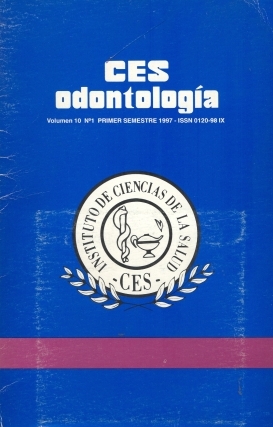RELACION ENTRE FUNCION Y FORMA CRANEOFACIAL. MEDICIONES DE LABIO Y LENGUA EN SUJETOS NORMALES Y CON EXCESO VERTICAL
Abstract
El objetivo del estudio fue relacionar la tensión pasiva labial y lingual y la presión labial en reposo, con el apiñamiento dental y la forma craneofacial. Se realizó en 40 pacientes de ambos sexos, con edades entre 16 y 30 años: 20 con mordida abierta anterior y altura facial inferior aumentada y 20 sin alteraciones oclusales o faciales. Se utilizaron un manómetro electrónico, un lipsómetro y un glosómetro para medir la presión pasiva labial, la tensión pasiva labial y la tensión pasiva lingual respectivamente.- En el grupo con exceso vertical las medidas fueron mayores en la altura facial, overbite, ángulo silla nasion con plano mandibular, longitud mandibular, ángulo goníaco, hendidura interlabial y altura del labio inferior. Dentoalveolarmente el ancho intermolar e intercanino fue mayor para el grupo con exceso vertical, pero la angulación de los incisivos inferiores fue mayor para el grupo normal. No se encontraron diferencias en cuanto a las variables funcionales (tensión pasiva labial, lingual y presión pasiva labial). ABSTRACT ABSTRACT. Johnson N, Jiménez ID, Bermúdez JA. Relation between function and craniomandibular form; lip and tongue measurements in normal subjects and with vertical excess. CES Odont 1997; 10: This study is part of a macro investigation that recorded respiration, electrical muscle activity, occlusal force, muscle volume, muscle vectors, dental crowding, labial and lingual passive tension, and labial pressure at rest. The objective of this part of the study was to evaluate labio-lingual passive tension and labial pressure at rest and relate them with dental crowding and craniofacial form. Recordings were made in 40 young adults, of both sexes, aged 16-30 years. 20 with anterior open bite and 20 with normal occlusions. Passive labial pressure was recorded with an electronic manometer, a lipsometer was used to record passive lip tension and a glosometer to record passive tongue tension. Dental casts were taken to assess crowding. Statistically significant differences were found between cephalometric variables such as anterior facial height, overbite, silla nasion - mandibular plane angle, interlabial gap and inferior labial height, these variables were great for the open bite group, and also the intermolar and intercuspid width. The incisor mandibular plane angle was great for the normal group. Event though there were no functional differences between the groups in the functional variables studied, such as passive labial tension, passive lingual tension and pasive labial pressure.Downloads
Download data is not yet available.
Downloads
Published
2010-05-22
How to Cite
1.
Johnson García N, Jiménez Várgas ID, Bermúdez Angel J. RELACION ENTRE FUNCION Y FORMA CRANEOFACIAL. MEDICIONES DE LABIO Y LENGUA EN SUJETOS NORMALES Y CON EXCESO VERTICAL. CES odontol. [Internet]. 2010 May 22 [cited 2024 Jul. 2];10(1). Available from: https://revistas.ces.edu.co/index.php/odontologia/article/view/1079
Issue
Section
Artículo de Investigación Científica y Tecnológica
| Article metrics | |
|---|---|
| Abstract views | |
| Galley vies | |
| PDF Views | |
| HTML views | |
| Other views | |



